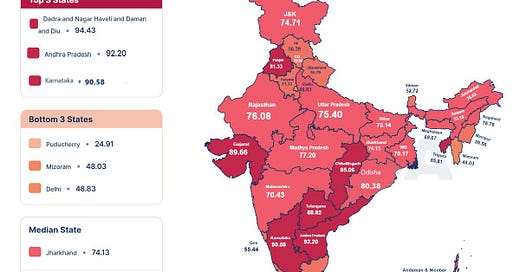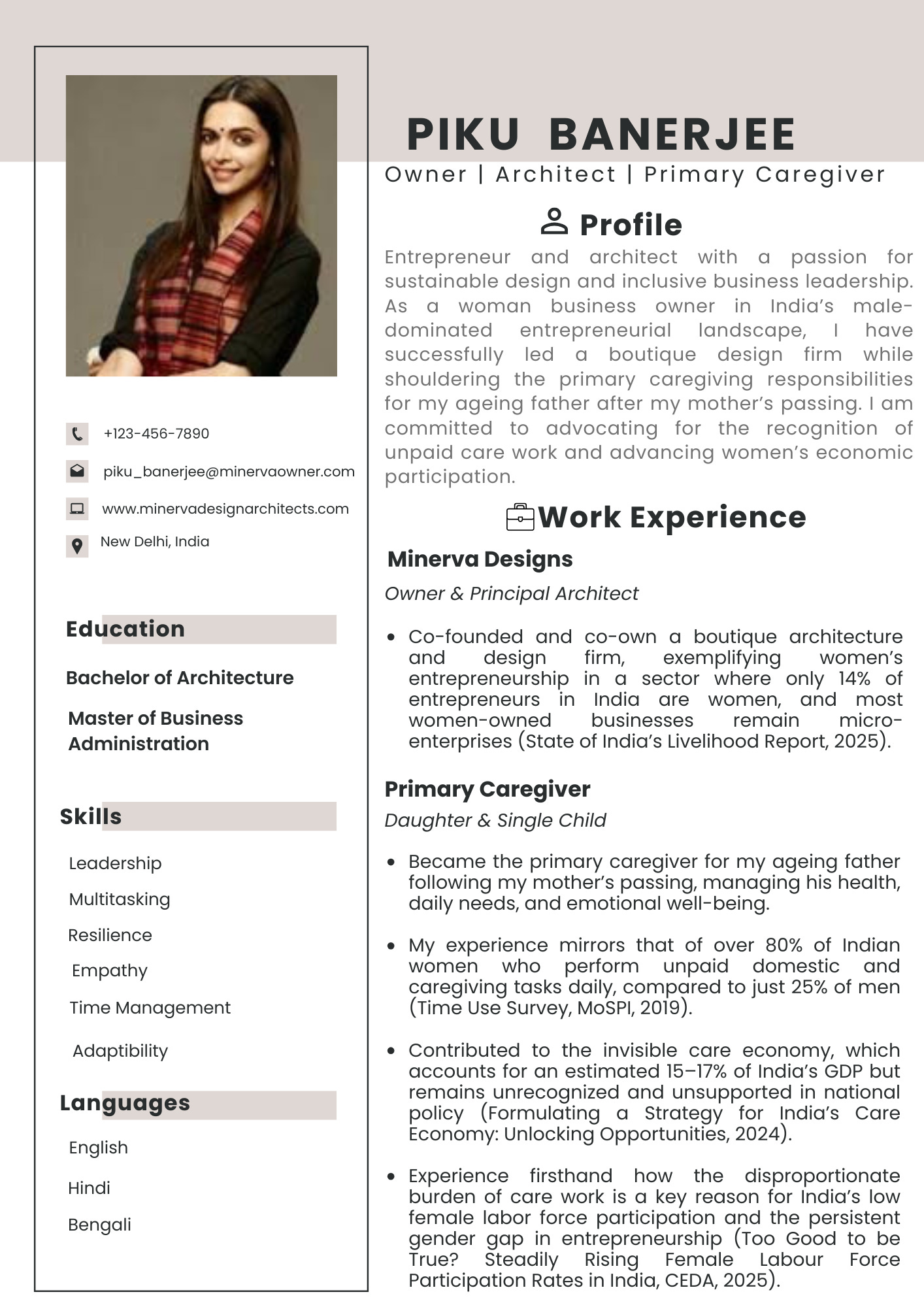Women & Work – What we’ve been following this May 2025
News, research, data, and recommendations about women and work - curated by our team
Hello, and welcome to CEDA’s newsletter ‘Women & Work’!
May in India means soaring temperatures, shifting schedules, and the unmistakable energy of summer. It’s a season that tests resilience, both inside and outside the workplace. Against this backdrop, we’re taking a hard look at the state of women’s work—where the pressure points are, what’s breaking through, and what still needs to change. This edition brings together the stories, research, and real talk that matter most this month, cutting through the heat and the hype to get to the heart of what’s moving the needle for women at work.
Before we get started, a request: We are curating ‘Women & Work’ with the hope that it can provoke, stimulate and amplify conversations about women’s participation in paid work in India. If you like this edition, please do share it on your social media, and with your friends, family and colleagues. Thank you.
In case you would like to read any of our past editions, they are available here.
🗞️ In The News
The gender gap in India’s formal workforce starts early and deepens quickly, according to McKinsey & Company’s Women in the Workplace 2025 report. Women account for 50 percent of university graduates, yet hold only 33 percent of entry-level private sector jobs and just 24 percent of managerial roles. Their representation continues to shrink up the ladder — making up only 16 percent at senior management and just 4 percent at the CEO level. The report points to structural obstacles such as biased hiring, lack of support systems, and workplace cultures that disproportionately push women out. The findings reflect how systemic barriers persist even in the face of growing educational parity. Read more from the report here.
If women can command Rafale jets in the Air Force, why are they still sidelined from merit-based roles in the Army’s legal branch? This is the question the Supreme Court posed while hearing a petition from two women officers who ranked 4th and 5th in the JAG (Judge Advocate General) selection but were denied entry due to limited “women-only” vacancies. Despite the role being officially gender-neutral, a 50:50 gender intake rule kept them out. The Centre defended its policy, citing operational needs and gradual integration, but the court wasn’t convinced— calling out the contradiction between meritocracy and outdated caps. The case signals a larger reckoning around equal opportunity in the armed forces. Read about the judgement here.
After more than a decade of relentless struggle, the Karnataka government has granted permanent employment to over 12,650 pourakarmikas (sanitation workers) in Bengaluru — the majority being women from Dalit communities who have historically endured exploitation and marginalisation. Chief Minister Siddaramaiah handed out appointment letters on May 1, marking a major milestone in a struggle that began in 2013. This decision, long delayed despite a 2016 government promise, comes as a partial implementation of the Chandrashekhar Committee’s recommendations. Previously working under exploitative contract systems, pourakarmikas now gain job security and benefits like provident funds, health insurance, and direct wage payments. Read the full story here.
Tripura has taken a major step by recruiting 332 women among 975 new constables, the largest induction of female personnel in the state’s history. This surge not only expands career opportunities for women but also strengthens their role in public safety and community engagement. With 2,407 women help desks, the 1091 women’s helpline, and nine dedicated women police stations, the state is creating a supportive environment for women both within the force and in society. Read more here.
💡 Research Spotlight
Employers and researchers alike have long debated whether tweaking job ad language can reduce gender gaps in applications. Words like collaborate, nurture, or support are believed to resonate more with women, while terms like ambitious or competitive are said to appeal more to men. But does this really influence who applies? A recent study by Cassondra Batz-Barbarich, Nicole Strah and Farhan Masud Ahmed put these assumptions to the test, using real-world job data to explore whether women are more likely to apply when job ads use "communal" language. The findings reveal a more complicated and sobering story.
How did the researchers test it?
They analysed 330 job advertisements posted on a U.S. university’s career portal, spanning a wide range of employers and sectors. These postings were linked to actual application data from more than 200 students—52 percent of whom were women—allowing the researchers to study behaviour, not just intention. Using linguistic analysis tools, the team coded each ad for its use of communal language (such as “support” and “teamwork”) versus agentic language (like “driven” and “leader”). They also examined whether the job descriptions emphasised communal goals, such as helping others or contributing to public service. Critically, the study accounted for the gender composition of each occupation using U.S. labour force data—a control variable often overlooked in earlier research but essential to isolating the effect of job ad language.
What did they find?
The study revealed that while language choices in job ads did have some impact, the key factor influencing women's decisions to apply was the nature of the job itself. Here’s a closer look at the findings:
Communal wording in job ads: No significant change in the number of female applicants.
Explicit communal goals in job ads: A slight increase in female applicants, but only when occupation type was not considered.
Gender composition of the occupation: The strongest predictor of whether women applied for the job.
In conclusion, female candidates were more likely to apply to jobs in women-dominated fields, regardless of the language used in the job advertisements.
Why does this matter?
The study's findings highlight a crucial point: simply altering the language in job ads won't be enough to overcome deeply ingrained societal stereotypes about gender roles. While inclusive wording has its place, it cannot change the fact that certain occupations are still perceived as "for men" or "for women." The real issue lies in occupational segregation—the division of careers by gender—that heavily influences who feels qualified or welcomed in different fields.
To dive deeper into the findings of this study, explore the full publication published in Journal of Personnel Psychology here.
📊 Datapoint
India’s Biggest Employer of Women? Their Own Families.
National Family Health Survey (NFHS-5, 2019–21) categorizes women’s employment into three types: self-employed (11 percent), working for others (13 percent), and working for family. The visualisation, sourced via CEDA’s Socio-Economic Data Portal (SEDP), zooms in on the last category—women working in respective family enterprises. 76 percent of Indian women in the workforce reported working for their own families, often without pay or formal recognition. Even in the states with the lowest share, nearly half of all working women fall into this category; in the highest, the figure exceeds 90 percent. This visual lays bare how deeply unpaid family labour continues to shape women’s work—and how invisible that work remains in conversations about employment.
The SEDP portal provides a powerful tool for exploring and analysing socio-economic data at the state and district-level across a range of sectors including health, education, and employment. Use SEDP to uncover critical socio-economic trends and drive informed decisions in research, policy, and advocacy. Explore here.
⏳ Throwback
Source: MullenLowe Global, "Inspiring The Future - Redraw The Balance," via YouTube.
What do children see when they imagine a firefighter, a surgeon, or a fighter pilot? A powerful short film by MullenLowe London begins with this simple question and the answers speak volumes - the deeply ingrained gender stereotypes around careers are laid bare through the eyes of children. When asked to draw people in these roles, the overwhelming majority of children drew men. Out of 66 drawings, only 5 featured women. That stark imbalance shows how early gender stereotypes shape children's understanding of the world and their place in it.
Then comes the plot twist and the reality check: real-life women— Tamsin, a surgeon; Lauren, a Royal Air Force pilot; and Lucy, a firefighter— walk into the room. Suddenly, the kids’ faces change. They try on helmets. They ask questions. They see possibilities. This campaign is a reminder that gender gaps don’t just show up in pay slips or boardrooms. They’re seeded early, in the small assumptions we let slide. Because careers aren’t only built on skills — they’re shaped by visibility, imagination, and who we believe we’re allowed to become.
📽️ Lights, Camera, Hustle: Women’s Work Lives in Movies
What if Bollywood scripts were backed by real-world stats? In this new series from Women and Work, we follow the journeys of some of cinema’s most memorable women—lawyers, journalists, cops, CEOs, teachers, domestic workers—and see how their reel-world struggles line up with the realities women face in those roles today. A little bit of drama, a lot of data, and a whole new way to look at work through the lens of pop culture.
This fictional CV is a creative work inspired by the character Piku Banerjee from Piku (2015), with all names and references respectfully credited to the film's original creators and rights holders.
Thank you for reading! If you have feedback, questions, tips, or just want to say hello, feel free to do so by replying to this email, or drop in a word at editorial.ceda@ashoka.edu.in
For more updates and conversations, be sure to follow us on LinkedIn and X. We look forward to staying connected with you!
Curated by: Sneha Mariam Thomas for the Centre for Economic Data & Analysis (CEDA), Ashoka University. Cover illustration: Nithya Subramanian









